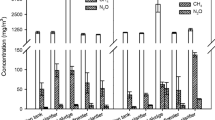Abstract
Recent studies about greenhouse gas (GHG) emissions show that sewer collection systems and wastewater treatment plants (WWTPs) are anthropogenic GHG potential sources. Therefore, they contribute to the climate change and air pollution. This increasing interest towards climate change has led to the development of new tools for WWTP design and management. This paper presents the first results of a research project aiming at setting-up an innovative mathematical model platform for the design and management of WWTPs. More specifically, the study presents the project’s strategy aimed at setting-up a plant-wide mathematical model which can be used as a tool for reducing/controlling GHG from WWTP. Such tool is derived from real data and mechanicistic detailed models (namely, Activated Sludge Model’s family). These latter, although are a must in WWTP modelling, hamper a comprehensive and easy application due to complexity, computational time burdens and data demanding for a robust calibration/application. This study presents a summary of the results derived from detailed mechanistic models which have been applied to both water and sludge line of a WWTP: primary treatment, biological reactor, secondary settler, membrane bioreactor, sludge digester etc. The project is organized in overall four research units (RUs) which focus each on precise WWTP units.
Similar content being viewed by others
References
Batstone DJ, Keller J, Angelidaki I, Kalyuzhnyi SV, Pavlostathis SV, Rozzi A et al (2002) Anaerobic digestion model no.1, Rep. No. 13. IWA Publishing, London, p 74
Caivano M, Saluzzi F, Caniani D, Masi S, Mannina G (2015) Development of an aerobic digestion model for the assessment of greenhouse gases production (AeDMG1): Calibration and validation. In: EuroMed 2015 Desalination for Clean Water and Energy Cooperation among Mediterranean Countries of Europe and the MENA Region, Palermo
Caivano M, Masi S, Mazzone G, Mancini IM, Caniani D (2017) Quantification of CO2 and N2O emissions from a pilot-scale aerobic digester, towards the validation and calibration of the first Activated Sludge Model for aerobic digestion (AeDM1). In FICWTM 2017: Frontiers International Conference on Wastewater Treatment, 21–24 May 2017, Palermo, Italy
Caniani D, Esposito G, Gori R, Mannina G (2015) Towards a new decision support system for design, management and operation of wastewater treatment plants for the reduction of greenhouse gases emission. Water 7:5599–5616, doi:10.3390/w7105599
Daelman MRJ, van Voorthuizen EM, van Dongen LGJM, Volcke EIP, van Loosdrecht MCM (2013) Methane and nitrous oxide emissions from municipal wastewater treatment – results from a long-term study. Water Sci Technol 67:2350
Esposito G, Frunzo L, Panico A, Pirozzi F (2011a) Modelling the effect of the OLR and OFMSW particle size on the performances of an anaerobic co-digestion reactor. Process Biochem 46(2):557–565
Esposito G, Frunzo L, Panico A, Pirozzi F (2011b) Model calibration and validation for OFMSW and sewage sludge co-digestion reactors. Waste Manag 31(12):2527–2535
Guo LS, Vanrolleghem PA (2014) Calibration and validation of an activated sludge model for greenhouse gases no. 1 (ASMG1): prediction of temperature-dependent N2O emission dynamics. Bioprocess Biosyst Eng 37:151–163
Henze M, Gujer W, Mino T, Van Loosdrecht MCM (2000) Activated sludge models ASM1, ASM2, ASM2d and ASM3. In: IWA Task Group on Mathematical Modelling for Design and Operation of Biological Wastewater Treatment. IWA Publishing, London, UK
Hiatt WC, Grady Jr CPL (2008) An updated process model for carbon oxidation, nitrification, and denitrification. Water Environ Res 80:2145–2156
Mampaey KE, Beuckels B, Kampschreur MJ, Kleerebezem R, van Loosdrecht MCM, Volcke EIP (2013) Modelling nitrous and nitric oxide emissions by autotrophic ammonia-oxidizing bacteria. Environ Technol 34(12):1555–1566
Mannina G, Ekama G, Caniani D, Cosenza A, Esposito G, Gori R, Garrido-Baserba M, Rosso D, Olsson G (2016a) Greenhouse gases from wastewater treatment — A review of modelling tools. Sci Total Environ 551–552:254–270
Mannina G, Capodici M, Cosenza A, Di Trapani D (2016b) Carbon and nutrient biological removal in a University of Cape Town membrane bioreactor: Analysis of a pilot plant operated under two different C/N ratios. Chem Eng J 296:289–299
Mannina G, Capodici M, Cosenza A, Di Trapani D, Viviani G (2016c) Sequential batch membrane bioreactor for wastewater treatment: effect of salinity increase. Bioresour Technol 209:205–212
Mannina G, Cosenza A, Vanrolleghem PA, Viviani G (2011) A practical protocol for calibration of nutrient removal wastewater treatment models. J Hydroinformatics 13(4):575–595
Morris MD (1991) Factorial sampling plans for preliminary computational experiments. Technometrics 33(2):161e174
Olsson G (2012) ICA and me - A subjective review. Water Res 46:1585–1624
Pocquet M, Wu Z, Queinnec I, Spérandio M (2016) A two pathway model for N2O emissions by ammonium oxidizing bacteria supported by the NO/N2O variation. Water Res 88:948–959
Acknowledgments
This research was funded by the Italian Ministry of Education, University and Research (MIUR) through the Research project of national interest PRIN2012 (D.M. 28 dicembre 2012 n. 957/Ric—Prot. 2012PTZAMC) entitled “Energy consumption and GreenHouse Gas (GHG) emissions in the wastewater treatment plants: a decision support system for planning and management” in which Giorgio Mannina is the Principal Investigator and Donatella Caniani, Giovanni Esposito and Riccardo Gori are the coordinators of the research units.
Author information
Authors and Affiliations
Editor information
Editors and Affiliations
Rights and permissions
Copyright information
© 2017 Springer International Publishing AG
About this paper
Cite this paper
Caniani, D. et al. (2017). A New Plant Wide Modelling Approach for the Reduction of Greenhouse Gas Emission from Wastewater Treatment Plants. In: Mannina, G. (eds) Frontiers in Wastewater Treatment and Modelling. FICWTM 2017. Lecture Notes in Civil Engineering , vol 4. Springer, Cham. https://doi.org/10.1007/978-3-319-58421-8_77
Download citation
DOI: https://doi.org/10.1007/978-3-319-58421-8_77
Published:
Publisher Name: Springer, Cham
Print ISBN: 978-3-319-58420-1
Online ISBN: 978-3-319-58421-8
eBook Packages: EngineeringEngineering (R0)




